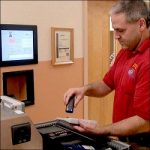
Cleanroom service provider uses RFID technology to optimize equipment management
[ad_1]
Micro-Clean, a Pennsylvania-based cleanroom service provider, uses an RFID system to help track, calibrate, calibrate the status of air detection tools in its lab and warehouse, and monitor the health of field equipment. The company is also considering offering customers the technology to help them identify the location of air filters and other related equipment, and when they were last serviced. The RFID solution, called Micro Clean Identification (MCiD), was developed by Verigenics.
A clean room is a closed space used to do some highly sensitive work, and the particles, impurities and pollutants in the room need to be strictly controlled. Businesses with clean rooms often need to work with a service provider like Micro-Clean to regularly measure the air quality in the room and check the function of the air filters to ensure air cleanliness using tools (such as air impurity sniffer). At the same time, regulatory agencies such as the Food and Drug Administration (FDA) also require cleanrooms to provide air quality certification and ensure that air testing tools are calibrated on schedule.

In the past, when calibrating, Micro-Clean technicians needed to look at the manual log book to see where the tool was and who was using it and search for it. Calibration technicians often need to email or call a field technician to confirm that the tools are calibrated on time. Tool and calibration records are more difficult to find if there are errors in the manual records (eg incorrect tool serial number).
Micro-Clean CEO John Wagner said cleanroom calibration requirements have become more stringent over the years. “We have to improve the traceability of these tools,” he said. “That way, the clean room can get proof of the calibration of these tools.”
According to John Wagner, cleanrooms can save a lot of labor costs due to the use of MCiDs.
In 2012, the company began developing a solution with Verigenics. Verigenics is the RFID division of NewAge Corporation. Wagner and Verigenics auto-ID program lead Jeff Johnson brainstormed. Wagner told Johnson that Micro-Clean technicians typically use tool carts to load the tools and then use vans to transport them to the site. Wagner came up with the idea of using RFID to trace these tools. Next, Verigenics started tagging these tools with high-frequency 13.56MHz passive RFID tags. Verigenics uses a variety of metal-mount, nylon and epoxy-encapsulated labels from multiple suppliers, Johnson said.
Verigenics installed three reading stations in Micro-Clean’s tool storage and calibration laboratory, one each in the tool entry and exit areas, and a third on a laboratory bench. Each reading station has a touch screen mounted on the wall, a custom-made tablet and a Datalogic Element Bluetooth handheld reader.

First, the field crew will use the tool cart to load those tools. Next, take the tools to the reading station with the tool cart, enter the ID number through the touch screen and use the reader to read the ID number of the tool tag. The reading station touchscreen then displays the tool description and serial number according to the database in the MCiD software. The software determines if the tool is close to its calibration date.
After all the tool tags are read, the staff will end the reading process according to the prompts, and the software on the local server will update the information of the person and the time of the take-out. The system then prints a checklist that the tools have been calibrated.
When returning tools, staff are required to go through a similar process. Follow the on-screen prompts to read the tool label to determine whether the tool should be sent to the storage area or the calibration area.
When using the pen holder system, the return and loan process for each tool cart takes 15 minutes. With the RFID system, this time was reduced to 3 minutes. It also saves the company $200,000 a year.
In the calibration laboratory, a technician will use a reading station to read the ID number of the tool tag, and the MCiD software will display the calibration task that the tool needs to perform. Once the calibration work is complete, the crew will use the MCiD software to record it and send it back to the warehouse.
This year, the company will launch the next phase of this deployment, attaching RFID tags to equipment in cleanrooms. So far, over 6000 items have been flagged. In the past, the company simply put sticky notes with names and contact details on the devices. Now, the company attaches an RFID tag to these customers’ devices. When Micro-Clean staff visit a customer site, they carry a tablet with a built-in RFID reader to read the tag ID number and begin inspection work. At the same time, the tablet can also periodically synchronize these data to the Micro-Clean server via a WiFi connection.
Previously, workers needed to enter device and customer information into laptops, a process that took five to six minutes to complete, Johnson said. Now this process only takes 20 seconds.
In addition, technicians can upload customer site RFID data at any time. This way, Micro-Clean can store the history of each device and their needs.
Wagner speculates that Micro-Clean will provide customers with value-added services for RFID functions in the future. This will be the third phase of MCiD deployment. In this scenario, customers will pay for data access. Employees at the client company can also read the RFID tag using an RFID reader to read the item’s service history and the date it was tested, repaired, or replaced.
Wagner noted that some of Micro-Clean’s customers have thousands of air purification units on site, and tagging those units simplifies the management of those units.
(The exclusive manuscript of rfid world network, please indicate the source author for reprinting!)
[ad_2]



